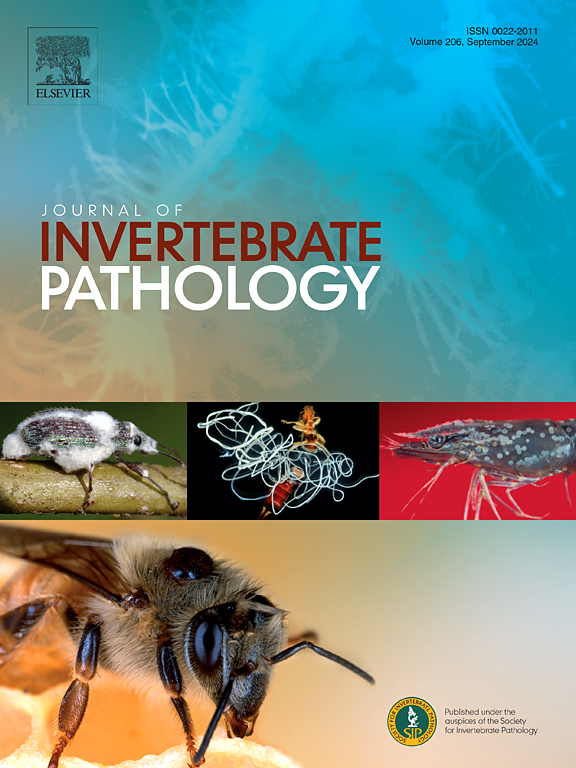瞄准根部!植物调节土壤基质中昆虫病原线虫、真菌和植物之间的多营养相互作用。
IF 2.4
3区 生物学
Q1 ZOOLOGY
引用次数: 0
摘要
在土壤基质中,昆虫病原线虫(epn)、绿僵菌和木霉真菌共享相似的土壤生态位和/或在其宿主范围内重叠。这些生物防治剂代表了生物防治战略的宝贵资源,在害虫综合治理计划中提供了合成化学农药的潜在替代品。然而,它们的共存会对各自的种群动态产生重大影响。我们假设,由于资源竞争和驱避化合物的产生等因素,真菌生物防治剂的存在可能会影响昆虫病原线虫的趋化性。双选择实验评估了线虫在真菌菌丝或真菌感染的寄主存在时对昆虫寄主的吸引力,以及豆类植物对这些相互作用的影响。结果表明,嗜菌异habditis bacteriophora、steinerma glaseri和S. feltiae对brunneum、afroharzium和贵州T. me的存在普遍排斥,表现出对健康昆虫幼虫的偏好。然而,豆类植物的存在显著减轻了这种驱避,创造了一个对epn更有吸引力的区域。嗜菌杆菌和绒球菌对有植物和真菌菌丝体的地区均表现出吸引力。glasernema表现出一种物种特异性反应,被M. brunneum排斥,但在植物存在时被T. afroharzianum吸引。这项研究强调了epn、真菌和植物之间复杂的相互作用,表明植物来源的线索可以调节线虫的行为并影响epn作为生物防治剂的功效。本文章由计算机程序翻译,如有差异,请以英文原文为准。

Aim for the roots! Plants modulate the multitrophic interactions between entomopathogenic nematodes, fungi, and plants in the soil matrix
Within the soil matrix, entomopathogenic nematodes (EPNs), Metarhizium and Trichoderma fungi share similar soil niches and/or overlap in their host range. These biocontrol agents represent valuable resources for biological control strategies, offering potential alternatives to synthetic chemical pesticides in integrated pest management programs. Their co-occurrence, however, can substantially influence their respective population dynamics. We hypothesized that entomopathogenic nematode chemotaxis would be impacted by the presence of fungal biocontrol agents due to factors such as competition for resources and the production of repellent compounds. Two-choice experiments assessed nematode attraction to insect hosts in the presence of fungal mycelia or fungal-infected hosts, and the influence of bean plants on these interactions. Results revealed that Heterorhabditis bacteriophora, Steinernema glaseri, and S. feltiae were generally repelled by M. brunneum, T. afroharzianum and T. guizhouense fungal presence, exhibiting a preference for healthy insect larvae. However, the presence of bean plants significantly mitigated this repellency, creating an area more attractive to EPNs. H. bacteriophora and S. feltiae exhibited attraction towards areas with both plants and fungal mycelia. Steinernema glaseri presented a species-specific response, repelled by M. brunneum but attracted to T. afroharzianum in the presence of plants. This research highlights the complex interplay between EPNs, fungi, and plants, demonstrating that plant-derived cues can modulate nematode behavior and influence the efficacy of EPNs as biological control agents.
求助全文
通过发布文献求助,成功后即可免费获取论文全文。
去求助
来源期刊
CiteScore
6.10
自引率
5.90%
发文量
94
审稿时长
1 months
期刊介绍:
The Journal of Invertebrate Pathology presents original research articles and notes on the induction and pathogenesis of diseases of invertebrates, including the suppression of diseases in beneficial species, and the use of diseases in controlling undesirable species. In addition, the journal publishes the results of physiological, morphological, genetic, immunological and ecological studies as related to the etiologic agents of diseases of invertebrates.
The Journal of Invertebrate Pathology is the adopted journal of the Society for Invertebrate Pathology, and is available to SIP members at a special reduced price.

 求助内容:
求助内容: 应助结果提醒方式:
应助结果提醒方式:


